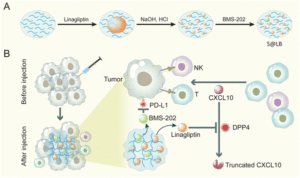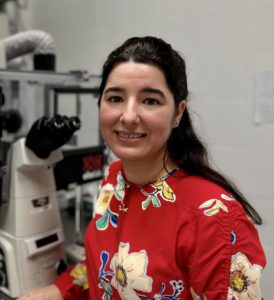In the last few years, immunotherapy has paved new paths for effective treatment of different cancers. Specifically, immunotherapy stimulates T cells, a type of white blood cell called lymphocytes that help to fight germs and destroy tumours. Immunotherapy can be used as a monotherapy or combined with chemotherapy and surgery. Unfortunately, cancer cells and their microenvironment have many sophisticated defence mechanisms that pose considerable challenges to immunotherapy effectiveness and progress. Current strategies to boost cancer immunotherapy include increasing the infiltration of T cells at the tumour site or blocking immune checkpoint-producing immune evasion.
In this regard, an exciting immunotherapy combination approach has been developed by Guixiang Xu and team based on an injectable hydrogel as a carrier to deliver a drug called linagliptin which is capable of inhibiting dipeptidyl peptidases 4 (DPP4) degradation. This leads to prolonged half-life of CXCL10 chemokines and thus, increases recruitment of T cells in the tumour site. Small molecule immune checkpoint blocker (BMS-202) particles were also loaded onto the developed drug carrier to block the programmed cell death-ligand (PD-L1), avoiding immune evasion. The team demonstrated that the application of hydrogel construct (S@LB) suppresses chemokine CXCL10 degradation, increasing T-cell infiltration, while BMS-202 particles inactivate PD-L1 checkpoint in vivo.

Fig. 1 Preparation and mechanism scheme of S@LB. (A) The preparation process of the S@LB solution. (B) Schematic illustration of an injectable hydrogel to reinforce cancer immunotherapy by promoting infiltration of T cells and regulating immune evasion. Reproduced from DOI: 10.1039/D3NH00401E with permission from the Royal Society of Chemistry.
The team tested the in vivo anti-tumour ability, immune response, and lung anti-metastatic effect of the S@LB in combination with chemotactic CXCL10 (S@LB + CXCL10). Their recent report shows that after 18 days of tumour removal, an immune memory effect was detected for the group treated with S@LB + CXCL10.
Overall, this study shows how nano-based hydrogel immunotherapy can be used as an innovative “weapon” against primary and distant tumours, along with efficient inhibition of lung metastasis, indicating tremendous potential for developing transformative clinical applications.
To find out more, please read:
Hydrogel-mediated tumor T cell infiltration and immune evasion to reinforce cancer immunotherapy
Guixiang Xu, Kai Liu, Xiangwu Chen, Yang Lin, Cancan Yu, Xinxin Nie, Wenxiu He, Nathan Karinc and Yuxia Luan
Nanoscale Horiz., 2024, Advance Article
About the blogger

Susel Del Sol Fernández is a Marie Skłodowska-Curie Postdoctoral fellow at Aragon Nanoscience and Materials Institute (INMA-CSIC), Spain and a member of the Nanoscale Horizons Community Board. Dr Del Sol’s research focuses on designing smart functionalized magnetic nanoparticles for biomedical applications, including magnetic-optical hyperthermia treatment and magnetogenetics. You can follow her on X @SuselDelSol
|










